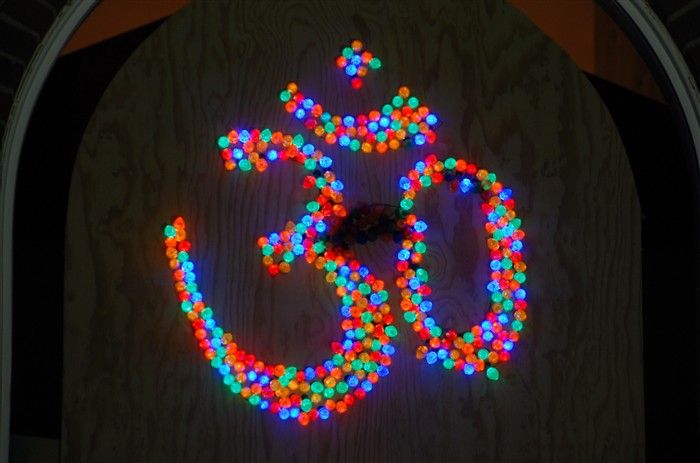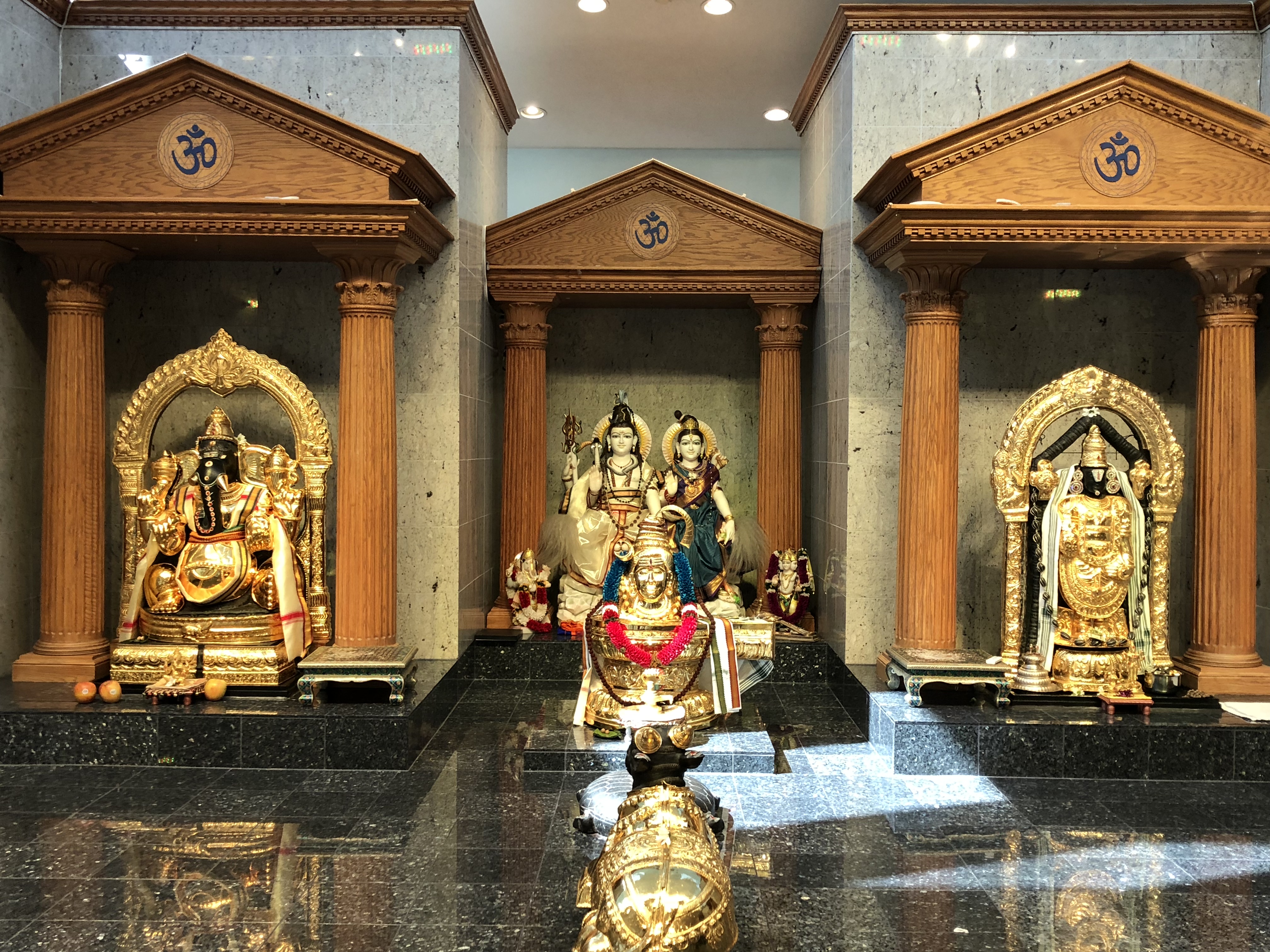Friday, May 27, 2005 : (First Day of the Four Day Program)
9 AM to 12 Noon
Alaya Pradakshina & Yaga Shala Pravesam:
The day began with the devotees carrying the Mangala Dravya(all the pooja materials necessary for the four-day celebration) arranged in platters, and performing Pradakshina or circumambulation around the temple and settling down in the “Yaga-Shala” or the area where all the austerities were observed.
Sri Ganapathi and Sri Vishwaksena Pooja:
Sri Ganesha was propitiated first, in order to eliminate all Vignas or Obstacles to ensure that the four-day ceremonies would proceed smoothly.
Swasti Punyahavachanam:
Since the Yaga-shala was built in an area where the wilderness had been cleared, it was rendered clean and purified for the purpose. This was done by performing the Swasti Punyahavachanam
Maha Sankalpam:
Maha Sankalpam is the pronouncement of the resolution, expressing the devout desire of the sponsors and the participants to install the Vigrahas or the Moorthies and animate them with Spirit for the purpose of worshipping them, and thereby engage in a once-in-a-lifetime opportunity of earning “Punya” or Spiritual merit that can last through countless rebirths.
Raksha Bandhanam:
All the sponsors and their spouses, and also all single persons seeking spouses, were offered protection by the tying of the Raksha or protective cord around their wrists.
Sri Ganapati Homam:
In the age prior to the building of temples, the customary religious rites always included the Homam or Havan – the fire sacrifice – which was done either in the domestic hearth or in a public arena. The Ganapati homam was then performed.
Ankurarpanam:
Ankurarpanam is the rite in which the nava dhanyas or nine types of grains are placed in potted soil and watered. In a few days, the grains would produce sprouts of all varieties. Their germination and growth is seen as the symbolic beginning and prosperous growth of the Devalayam or the abode of the Gods itself.
Jaladhivasam:
When the Shilpi or sculptor carves out of a shapeless block of granite the fine features of a divine image, a great deal of powdery stone still attaches to the figure. The impact of the chisel on the stone also produces countless sparks of fire. It is therefore believed that a number of ‘adhivasams’ or immersion ceremonies have to be performed in order both to clean and cool the moorthies. The first of these is the “Jaladhivasam” or immersion in water.
Arti and Teertha Prasada Viniyogam:
The morning’s proceedings concluded with the performance of Arti and the distribution of Prasad.
4 to 7 PM
Sri Ganapati Pooja and Ritvik Varanam:
Sri Ganapathi Pooja was performed followed by Ritvik Varanam. This is a ritual in which all the priests and their helpers are offered new dhotis and angavastrams to wear during the ceremonies. These garments are soaked in turmeric water and dried in the sun to make them clean and pure. The priests do not don them while eating or sleeping, and leave them behind in the temple for wear the next morning.
Samoohika Sri Lalita Deepa Pooja:
According to our Samkhya Darsana or school of thought, the indwelling twin elements of the cosmos are Purusa and Prakriti. Purusa is said to be Spirit or the Male Principle and Prakriti is Energy or the Female Principle. Since inexhaustible reserves of energy are required to build and support the Temple, the grace of Lalita Tripura-Sundari is eagerly sought. Since she is envisioned as fire, light, energy, and power, the ladies participated in a collective pooja by invoking Lalita in a Deepam or Lamp.
Dhanyadhivasam:
The Moorthies were immersed in paddy. The proceedings concluded with the performance of Arti and distribution of Teertha Prasada.
8 to 10 PM
Cultural Program _ Sampradaya Devotional Music By Kalyanaraman Bhaghavatar group
Saturday, May 28, 2005: (Second Day of the Four Day Program)
9 AM to 1 PM
Sri Ganesha Pooja & Ashtotara Shata Kalasa Sthapana:
After the Sri Ganesh Pooja, the Ashtotara Shata Kalasa Sthapana was done. This involved setting up of 108 vessels which were filled with water that was subsequently used for the Abhishekam or the ritual bathing of the deities and also for Kumbhabhishekam or the consecration of the Kumbhams or Spires on top of the Temple on the final day.
Navagraha Vastu Pooja:
Vastu Purusha is said to be the person on whose body is erected the temple itself, according to the principles of Vastu Shastra – a compendium of rules for the construction of all buildings. The Navagrahas or the nine planets which cast their considerable power and influence on the course of our lives were also propitiated.
Yaga Mandapa Devata Homam:
This Homam or Havan is primarily for the deities installed in the Yaga Shala itself – that is Sri Ganesha, Vastu, Navagrahas, the Ashta Dikpalakas or lords of the eight directions, and a few others
Pushpadhivasam:
This involved the immersion of the moorthies in heaps of flowers.
4 to 7 PM
Sri Ganapati Pooja and Pradhana Moorti Homam:
After Sri Ganapati Pooja, the Pradhana Moorti Homam or Havan was performed for all the moorthies that are going to be installed inside the Temple itself.
Samoohika Sri Satyanarayana Pooja:
In most religions, God is referred to as Truth. In the Hindu tradition, Sat – Truth or Pure Being – is considered the highest Reality; as Sat, it is also conceived as Chit or Pure Consciousness, as Ananda or Pure Bliss. In the Satyanarayana Vratam, we are reminded that by whatever name we may call God, or in whatever form God is seen, all names and forms refer to the nameless, formless one, that dwells beyond the world of duality. The Satyanarayana Vratam was celebrated as a collective Pooja in which all couples were free to participate.
Shayyadhivasam:
Here, the Moorthies were wrapped in new garments and put to bed under new blankets and pillows.
The proceedings were concluded with performance of Arti and distribution of Prasad.
8 PM to 10 PM
Cultural Program: By children predominantly from around Central Illinois (details published separately)
Sunday, May 29, 2005: (Third Day of the Four Day Program)
9 AM to 1 PM
A. Special Jain Ceremonies inside the temple. Please visit the link for a detailed documentation of the Event.
http://owa1.suryatechnologies.com/exchange/pbabu/Inbox/RE:%20Jain%20Pratishtha%20Details.EML/1_multipart_xF8FF_2_Souvenir%20for%20Prathishtha060905.pdf/C58EA28C-18C0-4a97-9AF2-036E93DDAFB3/Souvenir%20for%20Prathishtha060905.pdf?attach=1
B. Continuing Ceremonies in the Yaga Shala
Sri Ganapati Pooja, Gopura Kalasa Sthapana:
After Sri Ganapati Pooja, Gopura Kalasa Sthapana was done in which the Kumbhams or Spires which were going to be installed on top of the Temple Tower were first consecrated and then installed.
Yantra Pooja:
Yantra, Mantra, and Tantra are said to be the triune aspects of Hindu Worship. Yantras are copper plates on which are engraved the Mantras and sacred syllables. It is on these plates that the Moorthies were placed and it is from these Yantras that the Moorthies derive their power, since the power itself resides in the Mantra.
Sarva Devatha Sthapana Homam:
This involved Homam or Havan for all the deities which are to be installed in the Temple.
The proceedings concluded with the performance of Arti and Prasada distribution.
3 PM to 7 PM
Sri Ganapati Pooja and Moorti Sthapana:
After the Ganapati Pooja, we came to the most important ritual of the four day ceremony – the Vigraha Prathishta or the installation of the Moorties on the Yantras. This is the occasion when devotees offered precious stones to be placed on the Yantras of their preferred deities or Ishta Devatas.
Jeeva Kala Avahanam:
This involved the turning of the inert stone idol into a powerful, animate force, invested with Prana and all the Kalas or attributes associated with the particular Deity.
Pancha Gavya Snapanam:
Maha Abhishekam was performed for all the installed deities with the water of the 108 Kalasas.
The proceedings concluded with performance of Arati and Prasad Distribution.
8 PM to 10 PM –
Cultural Program – Classical Karnatak Music Concert by Nagamani Srinath.
Monday, May 30, 2005: (Fourth Day of the Four Day Program)
9 AM to 12 Noon
Sri Ganapati Pooja and Prathama Archana:
After Sri Ganapati Pooja, the Prathama Archana or the first Ashtottara Shata Nama Pooja – the chanting of the 108 names for each deity was performed. This was the most auspicious event. Sankalpam was done for all the sponsors of this Prathama Archana.
Gopura Kalasa Pradakshina & Maha Kumbhabhishekam:
Devotees performed Pradakshina around the temple, carrying the water of the Kumbhams, which was used to perform the Abhishekam on the Gopuram, as the final act of consecration.
Maha Naivedyam was offered followed by the chanting of the Mantra Pushpam.
Arti and the distribution of Maha Prasad.
2 to 4 PM:
Srinivas Kalyanam
Purusha, the Male Principal, and Prakriti, the Female Principal, coexist together eternally, intertwined as One. This is the meaning of the assumption that every male deity has a female consort. Even when standing by Himself, Siva is sometimes depicted as the androgynous figure of Ardhanareeswara – the Lord who is half female.
The word “Kalyanam” has come to mean marriage. Its technical meaning is “auspicious”. In this context, it is the auspicious union of Purusha and Prakriti, which is referred to as Nitya Kalyanam – a metaphysical allusion to their eternal union.
A regular marriage ceremony was performed for Lord Venkateswara and Padmavati.
This is also the reason why the Grihastha Ashrama or married state is considered the highest of the four ashramas.
All parents who have sons and daughters of marriageable age were encouraged to sponsor the Sreenivasa Kalyanam and receive the blessings of Lord Venkateswara for the marital felicity of their sons and daughters.
Sanmanam, Awards and Recognition:













